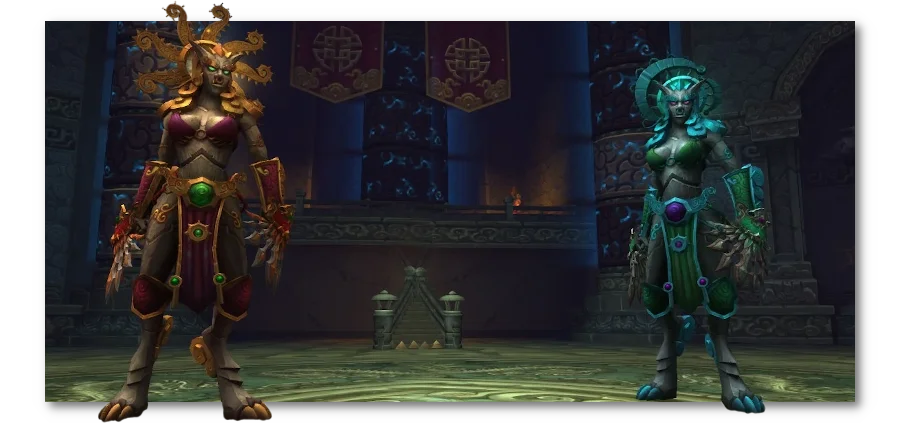Around September 2021, World of Warcraft deployed a set of unnannounced changes to a variety of seemingly inconsequential things in the game. This included a change of the icon for a mount called the Big Love Rocket to look less like a penis and more like the actual mount, which, for all that it was a pink rocket didn’t actually look like a rounded dildo. A number of artworks in-game were changed, like little decals of ladies with their boobs out were turned into things like a ladies without her boobs out, and a bowl of fruit.
Amongst these changes was two raid bosses from Mists of Pandaria, a 2012 expansion to the game. They were renamed from the Twin Consorts, and are now known as the Twin Empyreans.
These changes, which occurred in the wake of the shocking news of the State of California’s lawsuit against Blizzard, were received by the audience in a serious, and composed manner.
I am of course, understating, for comedic effect.

People got mad. Most of those people who got mad were silly, and sucked. And I don’t want to just straight up rip the Evitel and Taliesen video on the subject, which is a shame, because their joke about Prince Phillip was really funny, but instead I want to talk about how you name things in games and what that implies.
Okay, first of all, a brief bit of context. This is a raid encounter – a bit like a boss monster that you’re meant to spend a meaningful amount of time fighting, and for that fight to involve a variety of different mechanics. World of Warcraft is a really iconic example of a kind of labour game, where your time can largely be spent doing a series of tasks that are individually, not particularly hard, but you will do them a lot, over and over, until the practice of doing them is basically unconscious. Then, the game introduces a new layer of tasks to do, that again, are not particularly hard individually, and so on and so on.
The way this game does it is in a steadily increasing variety of game experiences, with similarly steadily increasing game rewards. One common trick is gear. In World of Warcraft, your character levels up, which gives you some advantages in fighting enemies and doing things you want to do, but that doesn’t represent how tough you are, how hard you hit, really, until you factor in the gear your character has that lets them hit harder, take more hits, so on. The game has about seven levels of gear that’s colour coded. You get level 1 as junk, level 2 is kind of what you get for showing up, level 3 is stuff you get for doing quests that you’re expected to do, and then the game introduces team content, known as dungeons. Dungeons give you level 4 stuff, usually, and that stuff is just pointedly better than the gear you have otherwise. This means you get a pull to go do dungeons. Then when you hit the level cap, you’ll find the next level of gear, which is the level 5, and that shows up in the type of content known as a raid.
At each step of this content, it’s scaled up in complexity. It’s not that the game is inherently more difficult as it progresses – late game is not about making judgment calls or having a deep understanding of systems, but is more about being aware of how you’re meant to apply your job to the events happening to you, and it’s often a complaint by some people (like Dave Sirlin, who I think is silly) that because you can reliably turn practice into to getting better at WoW, you can’t really be considered to be skilled at it.
There’s a conversation around World of Warcraft that forwards the idea that the end game is full of whatever you personally find fun to do, but the game definitely wants to push you towards doing raids, as that’s a great return, from the developer’s return on investment of time. A dungeon is going to please five people at a time, if it’s good, a raid will be able to entertain ten to thirty. Raiding is, while the game may profess otherwise, ‘the end game’ content. Each expansion features about three to five raids of varying size. In Mists of Pandaria, the expansion that had the raid boss we’re talking about, there were five raids, with boss counts varying from small (four) to large (fourteen). In this raid in particular, it was a mid-expansion patch that introduced a daily quest hub, a reputation grind, a world raid boss, dinosaurs, and in this raid, this boss encounter represents one boss of thirteen. The raid in question was new content in 2013, and has been irrelevant since basically march of that year.
This is the name of two raid bosses in content that does not matter and has not mattered for nine years.
Be very cautious of people who are mad about this.

Anyway, the thing is, these characters used to be named ‘twin consorts.’ Now, they’re called the Twin Empyreans. The patch that changed them also updated their official description, from this:
The Twin Consorts are said to be greatest of the Thunder King’s treasures. Rumored to be the only known female mogu in existence, Lei Shen keeps his trophies close and their combined arsenal against interlopers closer.
to this:
The Twin Empyreans are among the most formidable of the Thunder King’s champions. Determined to safeguard his reign, Lei Shen keeps his loyalists close and their combined arsenal against interlopers closer.
Now, some people like to argue hey, it’s not a problem that they were called consorts, consort is a real title. Consorts exist. The Prince Consort is the Queen of England’s husband, for example. But then the argument tends to try and leave off one of those details about what a consort is, as if the extent of the conversation is naming someone in the real world who has it, or as if the rest of that text doesn’t exist.
In the first text, they are referred to as literally his treasures and his trophies. In the Followup, those terms are replaced with champions and loyalists. It’s very hard to see a good faith actor complaining about this change when you see all the choices made – they were not just changed from Consorts to Empyreans, they were also changed from treasures and trophies to champions and loyalists. They went from being described as if they were objects, to being described as people with an allegiance, which is a choice, even as mild as it is here.
You just have to look at the words, in the context, once, and go : Oh no, this is obviously a simple, easy change to turn a pair of minor women characters from being described in a really gross way to a less gross way and it doesn’t cost you or lose you anything, in irrelevant content.
But they don’t want you to do that. They don’t want you to look at the context, at the whole of the message, and especially not in light of many of the people instrumental in this content being developed leaving the company in light of being outed as horrible abusive jerkholes. Instead, what they’d really like, is for you to argue with them about the problem in the smallest, lowest level. Then when you’re used to arguing that, they can expand the argument a little, but still only by bringing up other things you think you can handle, and then other, bigger things you think you can handle.
The bad faith arguments about this bullshit, which you do not have time to treat like it’s not bullshit, is the same kind of labour cycle of energy-wasting tedium that World of Warcraft masterfully employs.